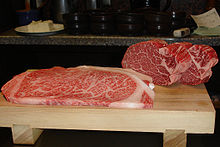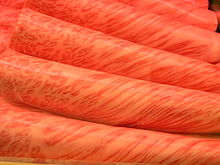
Wagyu
beef displayed at a restaurant
in Kobe.

Extensive
fat marbling in slices of high-grade
wagyu beef.
Wagyu
refers to several breeds of cattle
genetically predisposed to intense
marbling and to producing a high percentage
of oleaginous unsaturated fat. The
meat from wagyū cattle is known worldwide
for its marbling characteristics,
increased eating quality through a
naturally enhanced flavor, tenderness
and juiciness, and thus a high market
value. In several areas of Japan,
beef is shipped with area names. Some
examples are Kobe, Mishima, ÅŒmi beef
and Sanda beef. Highly prized for
their rich flavor, these cattle produce
arguably the finest beef in the world.
These different breeds produce beef
that range from expensive (by any
measure) to extremely expensive (about
$500 USD per 150 grams of filet steak
sold retail in Japan).
The
wagyū cattle's genetic predisposition
yields a beef that contains a higher
percentage of omega-3 and omega-6
fatty acids[1]
than typical beef. The increased marbling
also improves the ratio of monounsaturated
fats to saturated fats.
History
Japan
Wagyu
were initially introduced to Japan
as a beast of burden to help cultivate
rice. By order of the Shogun, the
cattle herd in Japan was closed and
eating meat from any four legged animal
was prohibited from 1635 to 1838.
Because of Japan's rugged terrain
and isolated areas, different breeding
and feeding techniques were used such
as massaging or adding beer or sake
to their feeding regimen. It is suggested
that this was done to aid in digestion
and induce hunger during humid seasons
but appears to have no effect on the
meat's flavor. Massaging may have
been to prevent muscle cramping on
small farms in Japan in which the
animals did not have sufficient room
to use their muscles.[2]
There
are five major breeds of wagu: Japanese
Black, Japanese Brown, Japanese Polled,
Japanese Shorthorn, and Kumamoto Reds.
Japanese breed names include: Tajima,
Hida (Gif Pref.), Tottori, Shimane,
Kochi and Kumamoto. Kumamoto Prefecture
is famous for their red wagyū cattle.
The more famous black variety has
their origins in Kobe.
New
Zealand
Some
of the biggest Wagyu herds outside
of Japan are farmed in New Zealand,
both in feedlot and pastoral environments.
Australia
Australian
Wagyu Association is the largest Breed
Association outside Japan. Both Fullblood
and Wagyu cross cattle are farmed
in Australia for domestic and overseas
markets, including Taiwan, China,
Hong Kong, Singapore, Indonesia, the
U.K, France, Germany, Denmark and
the U.S.A.(3)
Australian
Wagyu cattle are grain fed for the
last 300-500 days of production. Wagyu
bred in Western Australia's Margaret
River region often have Red Wine added
to their feed as well. Although less
than 100,000 of the 28.8 million head
of cattle in Australia are Wagyu or
Wagyu infused, the long feed nature
of Wagyu production takes up 40% of
Australian feedlot space in any given
12 month period.
United
States
In
the United States, Japanese wagyū
cattle were bred with Angus cattle to create a crossbred
animal that would be more able to
survive the U.S. climate and ranching
methods. The meat of this crossbreed
was more marketable to the American
buyer. To the American buyer, the
meat of the Wagyū cow was "too white."[4]
The meat of the crossbreed provided
the balance of marbling and red meat
desired by American buyers. This crossbreed
has been named American Style Kobe
Beef.
Designed
to mimic the diet that Japanese cattle
were receiving, wagyū cattle in the
United States are fed a mixture of
corn, alfalfa, barley, and wheat straw.
As
of 2007 the U.S. cannot ship wagyū
beef to Japan as Japan requires that
beef imported from the U.S. be from
cattle not older than 20 months (wagyū
cattle are usually slaughtered at
30-35 months).[5]
References

